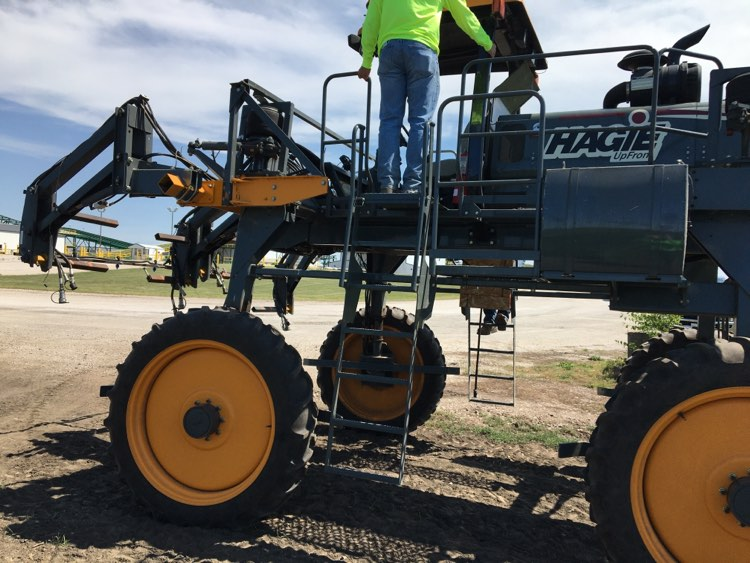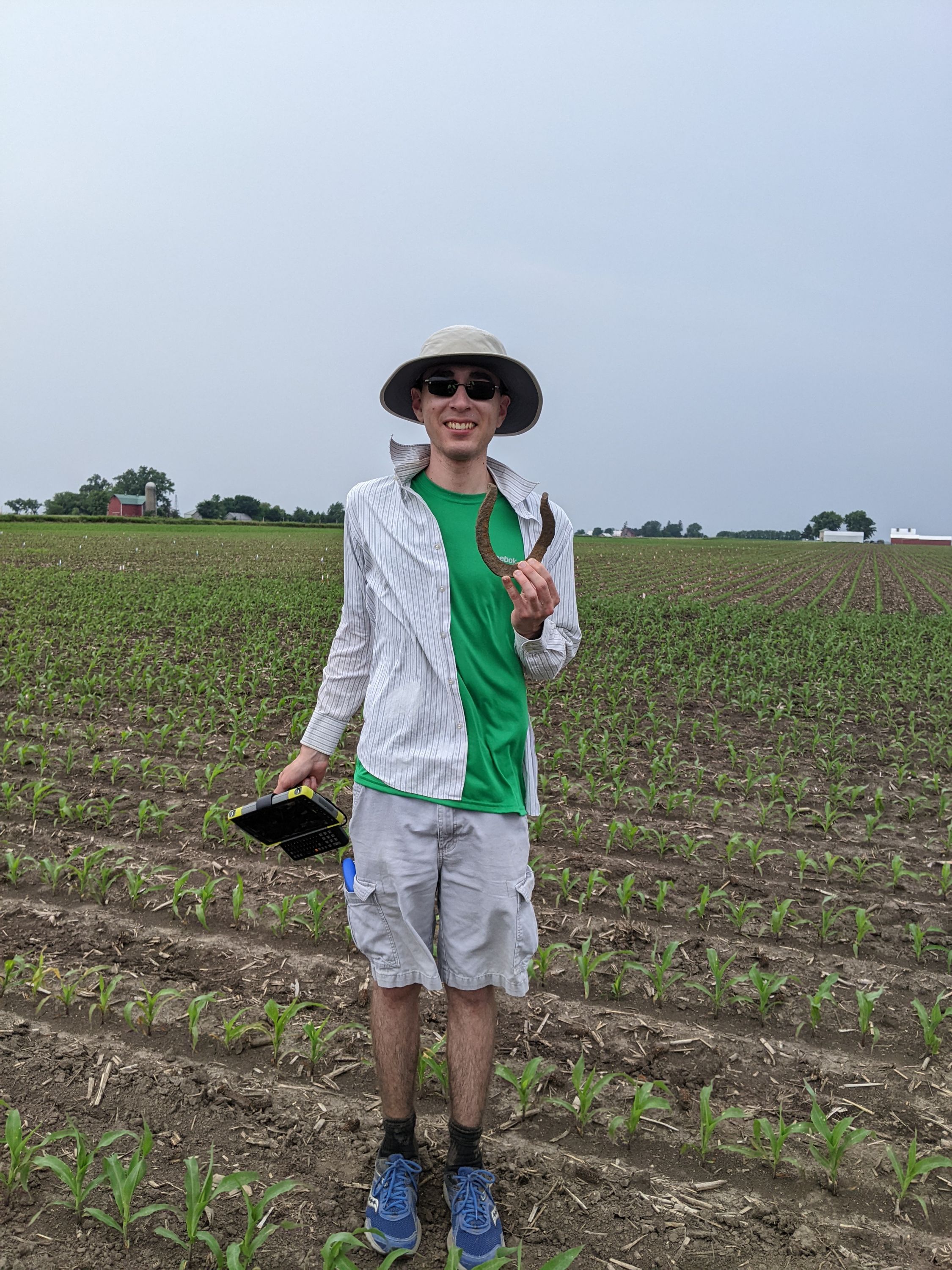Internship outcomes
Zhongjie Ji - Corteva Agriscience
I worked as intern in Corteva Agriscience (Johnston, Iowa) for a period of three months from June to September. During my three-month internship, I had the opportunity to work with farm detail solution (FSD) team. As an intern my primary responsibility was to support Dr. Lucas Borras to conduct the maize quality traits measurements and data analysis for different company products with different treatments from different locations. The successful research verified some hypothesis and introduced some new discovery. I am anticipating a published paper from this work. Besides this, I also helped with the nitric oxide research. In late season, I travelled a lot to the experimental stations in IA, NE and KS to help with harvesting experiment material.
My internship was a valuable experience that exposed me to a research driven seed industry. It is a good example that converted the outcome from scientific research to the commercial product in agriculture. Meanwhile this also enabled me to develop collaboration and communication skills within a big team. I had the opportunity to chat with people from various teams in the plant breeding inustry. My PhD research in maize quantitive genetics and phenotypic traits fit well with my internship. This experience has broadened my knowledge for physiological impacts on maize grain quality. while benefitting my future career goals.
I am grateful to Dr. Addie Thompson for allowing me to do my internship during an extremely busy field season and Dr. Lucas Borras for his guidance and support during my time with the company.
Davis Mathieu - Heinrich Heine Universität (HHU)
I was funded through the Jeff Schell Fellowships for Agricultural Science for my internship at Heinrich Heine Universität (HHU) in Düsseldorf, Germany. This collaboration has provided me with global perspective, some fluency in German, and a greater handle on computational modeling! I would encourage any MSU student to take advantage of our collaboration with HHU and a big thanks from the generosity of NRT-IMPACTS and The Bayer Foundation for making this possible.
Anna Haber - Bayer CropScience
I did my internship in the summer of 2022 at Bayer Crop Science. My title was Maize Genomics Intern and I worked remotely as part of the Breeding Innovation team. Not only was this a great opportunity for me to learn more about science in an industry context, I also gained technical skills related to genomic simulation and had a lot of great networking opportunities. Bayer places a big emphasis on networking for their interns, and I found that in contrast to academia, it’s perfectly acceptable to cold contact an experienced scientist high up in the organization asking for a 30-minute meeting to chat about their job and career trajectory. I took advantage of this to make a lot of new connections and learn about what someone’s day-to-day work may look like as a scientist on a team, a team lead, or a director of several teams.
In mid-July, I had the opportunity to visit the main Crop Science office at Chesterfield, Missouri, and work from there for a couple days. It was wonderful to meet most of my team in person and make connections across other teams as well, and a great taste of what work in a corporate office environment looks like. From there, I traveled along with about 60 other employees to various field sites in Iowa, where we got to see everything from breeding field trials and the facilities that support them to farms where the farmers are trialing Bayer products. One of the highlights was a panel of farmers and seed distributors who answered scientists’ questions over lunch one day; as someone with no agricultural background, I was fascinated to hear farmers’ perspectives. My internship wrapped up after this trip with a showcase where interns from all over the country presented their work, as well as a team meeting where I presented my results in-depth to my team. Overall, my internship was a great experience, which has led me to seriously consider pursuing a permanent industry position once I graduate from my PhD program.
Paulo Izquierido - Inari
During my internship at INARI in Cambridge, MA, I worked in the field of Quantitative Genetics / Computational Biology. My main project involved developing ensemble models that combined quantitative metrics to assess the severity of individual mutations in crop genomes, with the goal of identifying potential targets for genome editing. To complete this work, I gained proficiency in using INARI's cloud computational infrastructure and familiarized myself with their genomic data, including SNPs, genome assemblies, and population genetic summary statistics.
The internship provided an exceptional opportunity for me to explore the industry path and improve my programming and soft skills. Overall, I found the experience to be highly rewarding and valuable for my professional development.
Hannah Jeffery - Bayer CropScience
This summer, I participated in an internship with Bayer CropScience that completely
lived up to my expectations. I was assigned to work in a laboratory and collect moisture
data on pollen taken from the field, but there were more things I learned in the two
months I was there besides how to handle corn pollen. I not only learned how to drive
a Hagie (see below), but I also collected pollen from corn tassels, networked with
Bayer and PowerPollen executives, scouted fields, and worked on a crop with no prior
scientific experience. Since this was my first experience outside of academia, I was
interested in the differences between academia and industry. My advisor was knowledgeable
about working for Bayer. By working with him, I came to understand that being a Ph.D.
means working hard and investing time in the projects assigned, regardless of where
we work. Also, like academia, there is no 'faking it until you make it'! Unlike
academia, though, sometimes we do not get to see the projects to completion. This
was the case for me, as I will not get to hear about the results of my work this summer.
Regardless, I feel more energized than when I started this internship about working
in crop science. I enjoyed working with my colleagues, who all worked very hard and
were passionate about their work.

Serena Lotreck - Corteva Agriscience
My internship at Corteva far exceeded my expectations. I had wanted to be exposed to careers in industry and determine if I thought it would be a good path for me, in addition to picking up new skills in programming, data analysis, and modeling. Not only did I form meaningful connections with my mentors, I also made connections across and outside the company that will lead to potential academic (postdoc) and industrial job opportunities in the future. I had the satisfaction of a very interesting modeling result in my project that may help my team allocate funding and manpower to a new project, and without my internship, they may not have found the time to do this modeling. I learned through experience the valuable lesson that I already knew in theory about biology-computational collaborations, that it is good to always maintain contact and communication with the biologists that provide the data. Several times throughout the summer, it was only by communicating effectively with the biological members of our team that I was able to figure out that bizarre trends in the data were actually the result of something mundane, like cows escaping and eating the crops in an experiment. I learned a host of new computational and modeling skills, and was able to work with new kinds of data. I also got to participate in some fieldwork, and tour other parts of the company’s operations. I continue in contact with my direct mentor, and will possibly collaborate further with Corteva scientists if I am awarded the Fulbright I applied for in Chile (March 2024 start date), a research proposal that was only possible thanks to this internship.
Joshua Kaste - Yield10 Bioscience
I did an internship in the summer of 2022 with Yield10 Bioscience. The company is based out of Massachusetts, but my work for them was computational so I was able to do the internship remotely. I worked with the company's Senior Director of Metabolic Engineering on a cross-species transcriptomic analysis of the oilseed crop Camelina sativa in comparison to its close relatives Arabidopsis thaliana and Brassica napus. The goal of this work was to compare the transcriptomic profile of the developing Camelina seed with its relatives to identify potential targets that could be used to improve seed and oil yield in this species. By the end of the internship, this analysis had highlighted some potentially interesting targets for improvement. The work being done at Yield10 is closely related to my research, as my lab collaborates with them on a grant dedicated to Camelina improvement, but I enjoyed doing a different kind of analysis and looking at this system through a slightly different lens.
Robert Shrote - Wyffels Hybrids
I spent this past summer working as a plant breeding research intern for Wyffels Hybrids, a seed corn company. My main objective for this summer was to develop a “breeder’s eye.” For those who are unfamiliar with this term, a breeder’s eye is typically defined as the ability to visually assess a crop variety and determine whether it is good or not. A breeder’s eye is only developed through experience and is considered an art. Throughout the course of the summer, I learned that the aforementioned definition of a breeder’s eye is probably too narrow. There are many more facets to this skill than simple visual assessment of varieties. Based on my experience this summer, I would broaden the definition to include data quality control and decision-making processes which I would say both have artistic components to them.

I spent the first month of my internship traveling to different parts of Illinois, Iowa, and Wisconsin rating research plots on their ability to provide reliable data. Rating plots early in the season is crucial to ensuring good data inputs for downstream analyses. Analysis of low-quality data will ways lead to low-quality results. As I was rating plots, I was looking mostly for planting errors, skips, low plant counts, and uneven germination. In many circumstances, rating a plot is straightforward, but in some cases, the rating decision is more subjective. For example, if a research plot has a lower stand count than desired, but the plant spacing is uniform, the plants in the plot might be able to grow and compensate for the lower stand count. I also got to talk with several different breeders about how breeders go about making cross decisions. I have always been intrigued by this question, especially since most of my research revolves around studying the efficacy of different selection strategies. Going forward into graduate school, I have already begun to implement things I have learned from my internship with Wyffels Hybrids. When I arrived back at Michigan State University, one of the first things I did was rate my research plots for their ability to provide good data. In my future career, I will use what I have learned this summer to excel in my job.